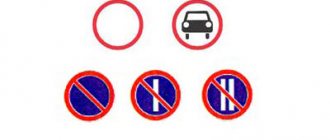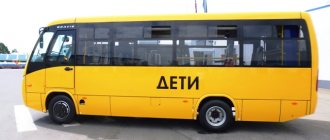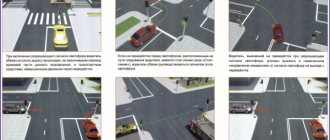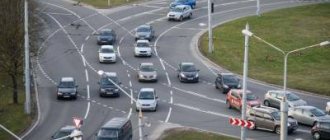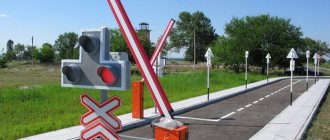Tightening of the rules for the passage of trucks in Moscow within the framework of the Cargo Frame began in 2014. The experiment showed an improvement in the environmental and transport situation in the Eastern District, after which restrictions were gradually introduced in all districts of the capital.
In this article we will tell you how drivers can plan a route along the frame so as not to receive a fine and what documents are needed for this.
- What is a cargo frame
- Which vehicles are subject to cargo frame restrictions?
- Why was the cargo frame introduced?
- Cargo frame map from August 1, 2020
- How to create a route using a cargo frame in Yandex.Navigator
- How to legally move off a cargo frame
- Fine for violating cargo frame rules
- Carriers' opinions on the cargo frame
What is a cargo frame
The streets of Moscow within the Moscow Ring Road were divided into two zones - “residential development” and “cargo frame”.
The cargo frame is the streets on which trucks must move.
The frame included ring highways (MKAD, TTK, SK), radial outbound highways, streets located away from residential areas and social facilities, and streets that significantly shorten the path of trucks.
Cargo Frame Road Sign Set
Truck movement on highways and roads for cars
The location of trucks on highways and roads for cars deserves special attention.
16.1. On highways it is prohibited:
- movement of trucks with a permissible maximum weight of more than 3.5 tons beyond the second lane;
16.3. The requirements of this section also apply to roads marked with sign 5.3.
Heavier than 3.5 tons. On motorways, category C trucks can only drive in the two right-hand lanes. They cannot enter the remaining lanes under any circumstances.
From 2.5 to 3.5 tons. As for trucks from 2.5 to 3.5 tons, on highways they can move in any lanes except the far left (if there are 3 or more lanes in a given direction).
Which vehicles are subject to cargo frame restrictions?
The restrictions apply to trucks weighing more than 2.5 tons. They must move around the capital only along the streets of the frame. This category of vehicle is prohibited from driving through residential areas.
There are exceptions when a truck can enter prohibited territory:
- When the driver goes to his home or work;
- To serve businesses, shops and citizens who are located there.
In this case, the driver must leave the permitted street and return to it from the intersection closest to the destination.
When and why did the 2.5 ton signs appear, a truck with a sign prohibited entry
Actually, this question is most relevant for the city of Moscow, where every meter of the roadway is worth its “weight in gold,” and even Gazelles can be considered cargo vehicles, which especially get in the way everywhere. At the same time, the same Gazelle has a permissible weight of less than 3.5 tons. This is where the issue arose when it was necessary to restrict the movement of trucks, but with what signs and how. As a result, you can see this Christmas tree made of signs...
Now let's try to figure out what these signs mean individually and what they represent as a trio. Sign “No movement” 3.2. Refer to the prohibition signs from chapter “3. Prohibition signs" section "Road signs and markings" in the traffic rules. The sign prohibits the movement of all vehicles, without exception, but with exceptions for:
— route vehicles; - mail, transport serving enterprises, transport of people living or working in the action of the sign; - on vehicles of disabled people of groups 1 and 2, or transporting them.
Now let's look at the signs. Table 8.4.1. extends the sign to trucks, including those with a trailer, with a permissible maximum weight of more than 3.5 tons. But 8.11 indicates that the sign only applies to vehicles with a permissible maximum weight greater than that indicated on the plate.
It can also be argued that these signs under sign 3.2 are just an addition to the “main” prohibition sign. This conclusion can be drawn from two conclusions. First, the signs refer to the traffic rules chapter “Additional information signs (placards)”. That is, it indirectly suggests that the signs cannot exist on their own, but only complement the main sign. Second, let us quote the first phrase from this chapter.
Additional information signs (plates) clarify or limit the effect of the signs with which they are used.
Note that there is no mention here that they can be the same clarification to any clarification, that is, a tablet to a tablet. It is said clearly and understandably. Plates are in addition to signs. As a result, how can you read the combination of signs that we cited above?
First, it prohibits the movement of the vehicle. The second is for trucks with a GMM of more than 3.5 tons. Third, movement is prohibited for all vehicles with a GVW of more than 2.5 tons. We don’t know about you, but for us this is simply an incompetence of those who put something like this on the road. These signs, to put it mildly, are dissonant with each other. And they mean, in the opinion of those who established them, a ban for all vehicles with a GMM of more than 2.5 tons. However, as we understand, formally the signs are designed to restrict specifically Gazelle-type trucks and those that are heavier. So, in this case, it would be more correct to use sign 3.4 “Truck traffic is prohibited.” The following explanation can be found for it.
The movement of trucks and vehicle combinations with a permissible maximum weight of more than 3.5 tons (if the weight is not indicated on the sign) or with a permissible maximum weight more than indicated on the sign, as well as tractors and self-propelled vehicles is prohibited. Sign 3.4 does not prohibit the movement of trucks intended for transporting people.
This is the logical option when the restriction should be for trucks and with the maximum permitted weight that we need.
Well, if we look deeper into the problem, the first option may well lead to the fact that drivers of even passenger cars with a permissible weight of more than 2.5 tons can formally be charged a fine for violating the “No Traffic” sign. And then prove in court that you are “not a camel.”
Why was the cargo frame introduced?
The transit of trucks through the city was limited in order to reduce the transport and environmental load in residential areas:
- reduce noise levels;
- reduce the concentration of harmful substances in the air;
- reduce the number of accidents;
- reduce traffic jams.
The initiative also came from Muscovites themselves - they asked the government to protect residential areas from noise and exhaust emissions.
Research by the Traffic Management Center showed that the project lived up to its goals. For example, in the Northern District:
- the number of truck accidents decreased by 19%;
- The death rate in road accidents decreased by 64%. By 30% - the number of wounded;
- The concentration of nitrogen oxide in the air decreased by 2.3 times;
- carbon monoxide and noise levels have decreased.
Surveys have shown that 73% of district residents support the introduction of a cargo frame and believe that this will improve the environmental situation.
The results of studies in other districts can be viewed on the Unified Transport Portal of Moscow.
Implement control of fines in the organization
Cargo frame map from August 1, 2021
We previously wrote that from August 1, 2021, cargo frame rules will be introduced in the remaining three districts of Moscow: Central, Western and Northwestern. In other areas they began to act earlier:
- in the Eastern District - since 2014;
- in the North and Northeast - from December 2016;
- in South-East - from December 2019;
- in Yuzhny - from February 2021.
Now the new rules for trucks apply throughout Moscow within the Moscow Ring Road.
A specific list of streets that make up the cargo frame has been established. The map can be viewed on the Unified Transport Portal of Moscow.
How to create a route using a cargo frame in Yandex.Navigator
In order not to get lost in the streets of the framework and to travel the shortest possible route, you can use Yandex.Navigator. The application can create routes specifically for trucks. To do this, in the navigator settings, enable the “Routes along the cargo frame” option.
When this option is enabled, the car icon will take the form of a truck. The function can only be used online; if there is no Internet, the route will be built without taking into account the cargo frame. If the destination is outside the frame, the navigator will warn you at what point you will need supporting documents.
Information about the streets included in the frame gets into the application from the Moscow Traffic Management Center.
New rules for trucks: what has changed and how to live with it
Visualization: transport.mos.ru
What documents do you need to have with you?
The truck driver must have a driver's license with the appropriate category, registration documents for the vehicle, an insurance policy, a waybill, documents for the cargo being transported, and, if living in the area, documents confirming registration at the place of residence.
How to drive now?
At the end of last year, the function of constructing routes for trucks in Moscow, taking into account the cargo frame, was added to Yandex.Navigator. To do this, you need to enable a special setting in the application.
“If the destination point is outside the frame, the Navigator will warn you where the cargo frame ends and remind you that special permission is required further. After launch, navigation along the “cargo frame” will work in test mode. You can only build routes for trucks with the Internet. If the connection disappears for a while and then appears, the application will rebuild the route according to the frame,” the company’s press service said.
Full list of streets where a cargo frame was introduced on February 1:
Southern Administrative District
1. Leninsky Prospekt 2. Mytnaya St.; 3. Lyusinovskaya st.; 4. Pavlovskaya st. from st. Pavel Andreeva to 8; 5. Podolskoe highway; 6. Derbenevskaya embankment; 7. Paveletskaya embankment; 8. Danilovskaya embankment; 9. Simonovsky Val st.; 10. Velozavodskaya st.; 11. Saikina st.; 12. Andropov Avenue; 13. Novodanilovskaya embankment; 14. Nagatinskaya embankment from the Danilovsky Bridge (railway) to the intersection with Andropov Avenue; 15. Nagatinsky Boulevard; 16. 1st Nagatinsky passage; 17. Projected passage No. 1809; 18. High street; 19. Sadovniki st.; 20. Akademika Millionshchikova St.; 21. 2nd Nagatinsky passage; 22. 3rd Nagatinsky passage; 23. Bolshaya Tulskaya St.; 24. TTK; 25. Novodanilovsky proezd; 26. Trofimova st.; 27. Kolomensky proezd; 28. Nakhimovsky Avenue; 29. Warsaw highway; 30. Kashirskoe highway; 31. Kashirsky passage; 32. Starokashirskoe highway; 33. Projected passage No. 3664; 34. 1st Varshavsky proezd; 35. Projected passage No. 3692; 36. Projected passage No. 1250; 37. 2nd Varshavsky proezd; 38. 2nd Kotlyakovsky Lane; 39. Kotlyakovskaya st.; 40. Kotlyakovsky passage; 41. 1st Kotlyakovsky Lane; 42. Moskvorechye st. from the intersection with Kotlyakovsky Proezd to the intersection with Proletarsky Prospekt; 43. Kolobashkina st.; 44. Marshala Shestopalova st. from the intersection with Kashirskoye Highway to the intersection with st. Moskvorechye; 45. Projected passage No. 6214; 46. Projected passage No. 5159; 47. Kantemirovskaya st. from the intersection with Projected Proezd No. 5159 to the intersection with Proletarsky Prospekt; 48. Proletarsky Avenue; 49. Kavkazsky Boulevard from the intersection with Proletarsky Prospekt to the intersection with Promyshlennaya Street; 50. Bakinskaya st.; 51. Lipetskaya st.; 52. Tarny passage; 53. Projected passage No. 1250; 54. Promyshlennaya st.; 55. Business street 7; 56. Projected passage No. 6414; 57. Projected passage No. 5109; 58. Dorozhnaya st.; 59. Projected passage No. 262; 60. Projected passage No. 257; 61. 1st Road Passage; 62. Dnepropetrovsky passage from the intersection with Varshavskoe highway to the intersection with st. Road; 63. Projected passage No. 5102; 64. Staropokrovsky passage; 65. 1st Road Passage; 66. Podolsky Kursantov st.; 67. Melitopolskaya st.; 68. Projected passage No. 5450; 69. Bulatnikovskaya st. from the intersection with the street. Nikopolskaya to the intersection with Projected passage No. 5450; 70. Nikopolskaya st.; 71. Stupinsky passage; 72. Projected passage No. 5449; 73. Gas pipeline st.; 74. Projected passage No. 4578; 75. Rossoshanskaya st.; 76. Rossoshansky passage; 77. 3rd Road Passage; 78. Brick Vyemki st.; 79. Projected passage No. 4579; 80. Mosstroyput st.; 81. Projected passage No. 4628; 82. Projected passage No. 5108; 83. Elevatornaya St.; 84. Kasimovskaya st.; 85. Ryazhskaya st.; 86. Biryulevskaya st.; 87. Zagoryevskaya street from the intersection with Biryulevskaya street to the intersection with Lipetskaya street; 88. Mikhnevskaya st.; 89. Lebedyanskaya st. from st. Mikhnevskaya to the intersection with Lipetskaya street; 90. Elevatorny Lane; 91. Donbasskaya st.; 92. Pedagogical street; 93. Mikhnevsky passage; 94. Zagoryevsky proezd; 95. Yagodnaya St.; 96. Besedinskoe highway; 97. Borisov Ponds st. from the intersection with Kashirskoye Highway to the intersection with Khordov Proyezd; 98. Projected passage No. 1819; 99. Khlebozavodsky proezd; 100. Projected passage No. 2147A; 101. 5th Kozhukhovskaya St.; 102. Dugovaya St.; 103. 6th Radialnaya St.; 104. Projected passage No. 6631; 105. Projected passage No. 892; 106. Projected passage No. 6630; 107. Projected passage No. 5453; 108. Krasny Lug st.; 109. Boychuk St.; 110. Kanatchikovsky passage; 111. 4th Zagorodny Proezd; 112. Sverzhevsky street; 113. Zagorodnoe highway 114. 2nd Tulsky lane; 115. Nagatinskaya st.; 116. Kolomenskoye highway; 117. Balaklava Avenue; 118. Sevastopol Avenue; 119. Khordovyi proezd (section from No. 21 on Brateevskaya Street and No. 18 on Borisovskie Prudy Street); 120. Projected passage No. 4902; 121. 2nd Pokrovskaya St.; 122. Projected passage No. 259; 123. Projected passage No. 6443; 124. Projected passage No. 6444; 125. Projected passage No. 6445; 126. Green Mountains st.; 127. Projected passage No. 714; 128. Projected passage No. 891; 129. Projected passage No. 439; 130. Projected passage No. 5402; 131. MKAD; 132. Projected passage No. 4423.
Southwestern Administrative District
1. Leninsky Prospekt (section from the Moscow Ring Road to Obrucheva Street); 2. Profsoyuznaya St., 3. 60th Anniversary of October Avenue; 4. Nakhimovsky Avenue; 5. Lomonosovsky Avenue; 6. Balaklava Avenue; 7. Obrucheva st.; 8. TTC; 9. 5th Zagorodny Proezd; 10. B. Cheremushkinskaya st. (section from 5th Zagorodny Ave. to Sverzhevsky St.); 11. Kakhovka st. (section from Sevastopol Avenue to Nametkina Street); 12. Nametkina st. (section from Kakhovka St. to Profsoyuznaya St.); 13. Bread passage; 14. Scientific passage; 15. Projected passage No. 6666; 16. Sevastopol Avenue; 17. Aivazovsky St.; 18. Yasnogorskaya st.; 19. Tarusskaya St.; 20. Golubinskaya st. (section from Tarusskaya St. to Karamzin Ave.); 21. Karamzin Avenue (section from Avenue No. 5063 to Golubinskaya Street); 22. Projected passage No. 5063; 23. MKAD.
How to legally move off a cargo frame
According to the rules, trucks cannot drive through residential areas. But, if the driver lives or works on a closed street, or needs to drive through for loading/unloading, then you can drive.
In order for the congress to be legal, you must have with you documents confirming the purpose of the trip. It could be:
- passport with registration;
- certificate of registration at the place of residence;
- waybill.
If there are no such documents, you cannot go.
Let us remind you that there are general restrictions on the movement of trucks in Moscow. More details about this in our separate article.
Fine for violating cargo frame rules
Compliance with traffic rules for freight transport is monitored by State Traffic Inspectorate employees and cameras. For ignoring road signs requiring the movement of freight vehicles, a fine of 5,000 rubles is provided (Part 7, Article 12.16 of the Code of Administrative Offenses of the Russian Federation). Trucks owned by foreigners are detained until a fine is paid.
You can pay the fine with a 50% discount within 20 days from the date of the decision.
To avoid missing these deadlines and avoid overpaying for fines, use the service. The service reports all fines issued to you as soon as they appear.
Checking fines for legal entities. persons
Do you want to monitor fines, receive a daily report on new fines found and pay them?
Try for free
Types of machines correspond to their purpose
A truck is designed to transport various types of cargo, since there is a continuous exchange in connection with developed commercial and industrial activities, there are also special vehicles designed for one or another type of transported cargo. The roads are crossed every hour by trucks, grain carriers, dump trucks, automatic couplers, vans, refrigerators that transport harvested crops, food, building materials, furniture, household appliances, cars and special equipment, animals, etc. Multi-ton trucks ply the roads every day. Since this type of transport is very specific, it is subject to its own specific criteria prescribed by traffic rules and regulations. The “No Freight Traffic” sign allows the city’s web of roads to “breathe” a little more freely, otherwise there would be congestion and the load on the road surface would be even greater than it is.
Carriers' opinions on the cargo frame
Based on the results of the pilot project in the Eastern District, carriers supported the idea of expanding the frame. Kommersant published the opinions of the heads of transport companies.
FM Logistic Transport Director Alexander Dyakonov believes that unorganized truck traffic is a problem for Moscow that needs to be resolved - not all streets in the capital are suitable for cargo maneuvers. In his opinion, the changes may cause temporary inconvenience in logistics and will require additional instructions for drivers and dispatchers.
For the transport and forwarding company PEK, the new restrictions did not create any obstacles to its work. “Drivers work on the basis of applications and route sheets, which indicate the addresses of clients. This gives the driver the right to deliver cargo to a street that is prohibited for travel,” commented the director of the delivery department, Sergei Grebenshchikov .
“ The cargo frame did not affect Diski of Ilya Nikitin, director of transport operations .
Chairman of the “Trucker” trade union Valery Voitko , commenting on the results of the introduction of the frame in the Eastern Administrative District, said that everyone gradually adapted to the change in routes.
So, in order to move around the cargo frame of Moscow without violations, it is better to plan your route in advance using a map, or use Yandex.Navigator. If there is a need to move off the frame in order to get to home, work or the place where goods are unloaded, be sure to take with you documents confirming the purpose of travel.
Have a question about the article?
Write to our specialist.
Don't miss new useful publications
We will tell you about the intricacies of the legislation, help you understand it and tell you what to do in controversial situations.
About fines
Responsibility for non-compliance with the sign is prescribed in the Code of Administrative Offenses of the Russian Federation. Fines now vary for ordinary cities and federal cities. In addition, the “No Freight Traffic” sign may prescribe times, as well as days and even an entire season, during which heavy trucks are not allowed to move along certain sections of the road.
Violation of the sign is subject to a fine of 500 rubles.
If freight traffic is prohibited, the fine for violating a sign in Russia is only 500 rubles, well, all or not all, it’s up to you to decide, but you still shouldn’t break the rules, it’s not for nothing that they were invented and prescribed, and not even in order to collect "tribute" violators, traffic rules, first of all, provide for order and safety on the roads. Moscow and St. Petersburg differed greatly in the amount of the fine. Drivers who blithely ignored the ban will have to pay 5 thousand rubles. But as you know, there are always many masters of breaking the rules, apparently, not everyone has yet matured to reasonable thinking, some serious issues remain in their zone of irresponsibility, which directly consumes some, so such drivers need to be stopped with at least something. Unfortunately, other people's examples won't stop everyone, but fines have a small impact on careless drivers.
